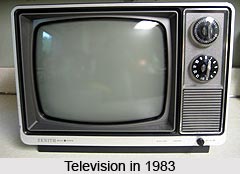History of private television in India depicts an era which is considered to be one of the most significant incidents in the timeline of Indian television. Private television in India or cable TV has its roots in the late seventies. Indian television viewers were demanding for more and more entertainment options, apart from what the government-owned broadcaster DD was offering.
 There was a genuine growth in video cassette recorder sales during this period. Enterprising individuals in apartment blocks placed a video in their homes or their garages and started to offer a cable TV connection to people who asked for it. The fare available with these private operators was Hindi and English movies and western comedies, music and game shows. At this stage, private television in India was restricted to the major metros and towns and the upper crust of society. The momentum for its spread came in 1990 with the beginning of the Gulf war. Ted Turner`s CNN started beaming news reports of the bombing of Kuwait by Saddam Hussein and sparked off a demand for satellite dishes. Only the affluent families could afford them. Some cable operators who had been running their Hindi and English movie channels added dishes and started to depend on CNN into homes. This spurred the demand for cable TV, making it a lucrative business and it attracted more individuals to the industry.
There was a genuine growth in video cassette recorder sales during this period. Enterprising individuals in apartment blocks placed a video in their homes or their garages and started to offer a cable TV connection to people who asked for it. The fare available with these private operators was Hindi and English movies and western comedies, music and game shows. At this stage, private television in India was restricted to the major metros and towns and the upper crust of society. The momentum for its spread came in 1990 with the beginning of the Gulf war. Ted Turner`s CNN started beaming news reports of the bombing of Kuwait by Saddam Hussein and sparked off a demand for satellite dishes. Only the affluent families could afford them. Some cable operators who had been running their Hindi and English movie channels added dishes and started to depend on CNN into homes. This spurred the demand for cable TV, making it a lucrative business and it attracted more individuals to the industry.
The launch of Star TV and Zee TV further enhanced the spread of cable TV. In the first half of 1992, almost 4,500 households were being cabled up regularly. That figure increased to almost 9,450 homes daily in the second half of the year, according to a study conducted by market research firm. From a mere 412,000 urban households in January 1992, the number of homes with private television channels went up to 1.2 million by November 1992. The number of homes estimated in 1993 was 3.3 million according to a survey. This is estimated to have gone up to 7.3 million by January 1994, according to one estimate. In end of 1994, the number of homes with cable television reached 11.8 million out of a total of 32.4 million TV owning homes.
 Subsequently, no widespread research was conducted by the industry which went by estimations until two readership surveys were conducted in 1995. The two national readership surveys, namely the Indian Readership Survey and the National Readership Survey pegged the penetration of C&S at below 10 million in 1995 whereas industry estimates placed it at least 14 million. The NRS said that 9.3 million homes in urban India owned private television while the IRS said that the numbers for urban and rural India were around 8.4 million and 3.4 million respectively. No further updates have been done because of the magnitude of the research covering a population of almost 70 million TV homes in recent days. Nevertheless, the satellite TV industry has increased its estimate for C and S homes to about 22 million now attributing to the increase of the spread of the private television networks in smaller towns, villages and untapped developing areas on the fringes of major metros, where private television is being installed in housing at the time of construction itself.
Subsequently, no widespread research was conducted by the industry which went by estimations until two readership surveys were conducted in 1995. The two national readership surveys, namely the Indian Readership Survey and the National Readership Survey pegged the penetration of C&S at below 10 million in 1995 whereas industry estimates placed it at least 14 million. The NRS said that 9.3 million homes in urban India owned private television while the IRS said that the numbers for urban and rural India were around 8.4 million and 3.4 million respectively. No further updates have been done because of the magnitude of the research covering a population of almost 70 million TV homes in recent days. Nevertheless, the satellite TV industry has increased its estimate for C and S homes to about 22 million now attributing to the increase of the spread of the private television networks in smaller towns, villages and untapped developing areas on the fringes of major metros, where private television is being installed in housing at the time of construction itself.
The business of private television in India has undergone a transformation as well. In the beginning it was small and run by entrepreneurs. At one time the cable TV operators population was estimated as high as 100,000. InCablenet - managed by the Hinduja group, Siticable - a joint venture between Zee TV promoter Subhash Chandra and Rupert Murdoch`s News Television, Asianet, Hathway Cable and Datcom, Ortel Communications and RPG Netcom - a company promoted by the RPG group were some of the prominent private television groups. While the Hindujas claim to have invested close to Rs 2000 million into their network building, Siticable planned to go for a higher figure of close to Rs 2500 million. But the MSOs have concentrated on the major metros only. They have yet to spread out into the smaller towns and the interiors of India over time where private television networks are still controlled by small businessmen.
International cable networking companies such as United International Holdings, TCI and Falcon Cable of the US, also tried their hands in the Indian television scenario. While UIH almost set up a joint venture with the RPG group which did not fructify, TCI or Time Warner discussed possibilities with the Times of India group, which was inconclusive. Falcon Cable however, was the successful group in establishing a joint venture with the Hindustan Times publishing group in New Delhi called India Information Technologies Ltd. An investment of nearly Rs. 50 million was made to buy a few small private television networks. The company however did not take charge of the networks, leaving them to be controlled by the cable operators. The joint venture was in legal action for quite sometime and finally Falcon Cable had to leave it. International investors and cable TV networks are still associated with the Indian cable TV market. United International Holdings joined partnership with liquor group UB. Falcon Cable and Cox Communications attained some semblance of order in this industry before committing further resources.
The entry of the big names in the business of private television that lead to consolidation amongst smaller operators, several of whom combined their resources to set up complicated headbands capable of delivering 30-50 channels similar to the bouquet of the MSOs. And as the MSOs increased the number of channels that they were offering earlier, the independents have also kept pace. Today, in most of the metropolitan cities, Indian viewers can hook into more than 65 channels. Some of the major agglomerations that emerged initially were Seven Star and Shree Bhawani in Mumbai, SkyVision in Ahmedabad; and Malleswaram Cable Network and UCN in Bangalore. By 1999, one of them had partnered with the fast moving Hathway Cable and Datacom. But they all operate on the similar model that is of franchising of their private television feed to smaller operators.
The programming that cable TV recently offers ranges from Hindi films to local events like fairs, religious discourses, civic elections, regional news, community games such as Bingo and favourite local sports. Practically, every network has at least two cable channels, sometimes both of which screen Hindi movies and songs. At one time they were also screened pirated or illegal versions of English movies. This ceased with the Motion Picture Association of America (MPAA) creating heavy pressure on these cable operators. But piracy keeps cropping up on private television networks the moment the pressure is eased. The larger private television networks have their own branded channels too, like the Siticable has SitiCinema; InCable has CVO while Hathway has C-News.
The programming on these private television channels is extremely popular that is evident from the audience share that they manage to garner. The private television channels rank second after DD on this parameter in all cities. As an example, private television channels accounted for close to 11.7% of share of the audience in Delhi in 1996 during prime time on Sunday evenings, and 8.4% on weekdays. The numbers for the other cities accounted for 8.4% and 4.6% for Chennai and Mumbai on Sunday evenings and 6.4% for weekdays in Mumbai during prime time. However, they cannot really attract advertising to the extent of their viewership because of the disjointed nature of the private television networks and there being no central body to function as a channelising agent for the thousands of networks in one single city.
Private television in India has gained immense popularity due to its impressive package of entertaining programs. These programs not only have high rate of audience viewing but also deals with massive businesses in the small screen industry. With the advent of private television, the indoor entertainment of Indians has to some extent been captured by these cable channels and their attractive shows.





